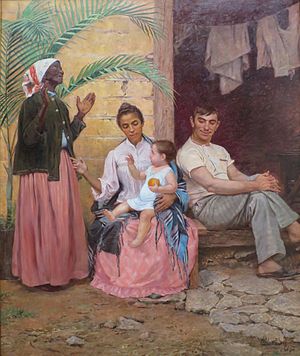The Redemption of Ham
This article, The Redemption of Ham, has recently been created via the Articles for creation process. Please check to see if the reviewer has accidentally left this template after accepting the draft and take appropriate action as necessary.
Reviewer tools: Inform author |
| The Redemption of Ham (A Redenção de Cam) | |
|---|---|
 | |
| Artist | Modesto Brocos |
| Year | 1895 |
| Medium | Oil on canvas |
| Dimensions | 199 cm × 166 cm (78 in × 65 in) |
| Location | Museu Nacional de Belas Artes, Rio de Janeiro |
The Redemption of Ham (pronounced [ɐ ʁɨ.dẽ.ˈsɐ̃w dɨ kɐ̃w]; A Redenção de Cam in Portuguese) is an oil painting on canvas by the Spanish Brazilian painter Modesto Brocos, in 1895. The painting; extremely controversial since it's inception; deals with the racial theories of the late nineteenth century and the phenomenon of the quest for the gradual "whitening" of generations of the same family through miscegenation. It is conserved in the Museu Nacional de Belas Artes in Rio de Janeiro.[1]. It is considered Modesto Broncos's masterwork as well as one of the most important artworks in the history of Brazilian painting due to its particular depiction of the complex racial issues that Brazil was experiencing at the time, given to the abolishment of slavery as well as the liberal immigration policies aiming at the racial "improvement" of a Brazilian population that saw itself as mixed but aspired to achieve whiteness, as well as the Europeanization of post-colonial Brazilian society. Broncos thus managed to produce poignant commentary of his contemporary society as well as a more general statement regarding Latin-American as a whole and its perpetuation of racial hierarchies akin to the previously maintained systems of colonial castes, even amidst the development in social change.
In the work of Modesto Brocos, in front of a poor habitation, three generations of the same family are portrayed. The grandmother, black, the mother, brown, and the child, phenotypically white. The matriarch, with an emotional countenance, raises her hands to the heavens in a gesture of gratitude for "redemption": the birth of the white grandson, who will be spared the hardships and memories of the slave-owning past. The scene was thus defined by Olavo Bilac:
Behold the dawn-child, as he smiles and shines, in the lap of the mulatto-dawn daughter of the deluge, granddaughter of the night. Ham is redeemed![1]
The title is a reference to the biblical episode of the curse of Noah on his son Ham and all his descendants as reported in the book of Genesis. Punishing Ham for mocking his nakedness and drunkenness, Noah prophesied that he, Ham, would be "the last of his brothers' slaves." As reported by Alfredo Bosi, the popular belief that the descendants of Ham would be the dark-skinned peoples of some regions of Africa, in addition to the tribes that inhabited Palestine before the Hebrews, served for a long time as an argument of ideologues and merchants to validate, during the colonial period and throughout the empire, the traffic of African slaves to Brazil. The sin of Ham would thus be the founding event of an immutable situation and the just divine punishment of a whole people. [1]
The period in which the work was produced was marked by intense scientific mobilizations (even if many of them fallacious); however, in referring to the biblical episode narrated in the book of Genesis, The Redemption of Ham seems to bet more on religion than on science to corroborate its perspective. There is, in the work, a perspective of religious court rather than a "scientific" look [2]. The work reflects the racist ideologies of the time by showing the laundering passed by the family as something to be praised by themselves. As Tatiana Lotierzo and Lilia Schwarcz point out in the article "Gender Race and Whitening Project: The Redemption of Cam" the women of the painting - the black grandmother and the mulatto mother - are disposed as if there was voluntarism from them in the process of laundering which sought to extinguish its own ethnic group. The work became the mark of an era that, imbued with a racialist thought, left indelible marks in the Brazilian tradition [2].
See also
References
- ^ a b c Couto da Silva, Maria do Carmo. "A Redenção de Cam". MARE - Museu de Arte para a Educação. Retrieved 4 July 2011.
- ^ a b Lotierzo, Tatiana; Schwarcz, Lilia (28 September 2013). "Raça, Gênero e Projeto Branqueador: "A Redenção de Cam"" (PDF). Retrieved 24 September 2017.
{{cite journal}}: Cite journal requires|journal=(help)
Notes
- Fantasio (pseudônimo de Olavo Bilac). Fantasio na Exposição. II - A Redempção de Cham. Gazeta de Notícias, Rio de Janeiro, 5 de setembro de 1895, p. 1.
- Bosi, Alfredo. Dialética da Colonização. São Paulo, Companhia das Letras, 1998, rep. 2007, pp. 257-258.
This article, The Redemption of Ham, has recently been created via the Articles for creation process. Please check to see if the reviewer has accidentally left this template after accepting the draft and take appropriate action as necessary.
Reviewer tools: Inform author |

